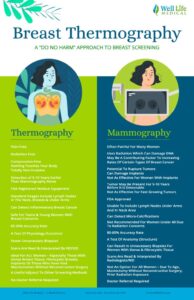 Each year, nearly 300,000 women are diagnosed with breast cancer in America alone, and about a sixth of them die from it.
Each year, nearly 300,000 women are diagnosed with breast cancer in America alone, and about a sixth of them die from it.
One of the keys to surviving breast cancer is early detection. Although we still don’t know exactly what causes breast cancer, there are signs of it that women and their health care providers can recognize:
In addition to self-examination, there are also advanced screening methods that can detect breast cancer in its early stages, vastly improving the chances of survival. Two of them are breast thermography and mammography, and since October is Breast Cancer Awareness Month, now is as good a time as ever to learn about them.
Mammography
Also called mastography, mammography uses x-ray imaging to examine the breast in an attempt at early detection of breast cancer and other diseases that can affect the breast.
During the procedure, the patient’s breast is placed on a flat support plate. Then a parallel plate known as a paddle compresses the breast. An x-ray machine then passes a small burst of x-rays through the breast and to a detector on the opposite side.
The process produces high-definition views of the breast tissue. This allows medical professionals to screen for breast cancer. For most women, the procedure is generally painless although they may experience some mild discomfort from the compression of the breast.
Different agencies have different recommendations for how early and often to have mammography performed. Since breast cancer is far more likely the older a woman is, many start undergoing screening by the age of 40 and by 50 at the latest, and the intervals tend to be yearly or every 2-3 years.
Breast Thermography
Breast thermography is another effective way to detect changes in breast health and to screen for the presence of breast cancer.
Approved by the FDA, breast thermography is non-invasive, safe, painless, and, unlike mammography, radiation-free. It’s also fast, usually performed in just 30 minutes.
Like mammography, breast thermography is an imaging procedure. It relies on an infrared scanner and a computer to measure temperature changes in the skin and blood vessels of the breast. Using that data, the procedure creates an infrared image. With breast cancer, there is increased metabolic activity and angiogenesis (formation of new blood vessels). Thus, areas with cancer have higher temperatures, which breast thermography detects.
Breast thermography is contact-free, so there is none of the discomfort patients sometimes experience during mammography due to breast compression.
In addition, breast thermography is a good alternative screening process for patients who cannot utilize mammography. This includes pregnant women (radiation risk), patients who are very sick, and patients with limited mobility.
Thermography can detect masses within the breast tissue earlier than mammography can, detecting growths as small as 2mm. While many doctors do not perform mammography on women under 40, breast thermography is available to women from their early 20s on.
No matter your age, race, or breast size, we can perform safe, effective, and painless screening with breast thermography. Learn more, or request a consult at BreastHealthAmarillo.com.